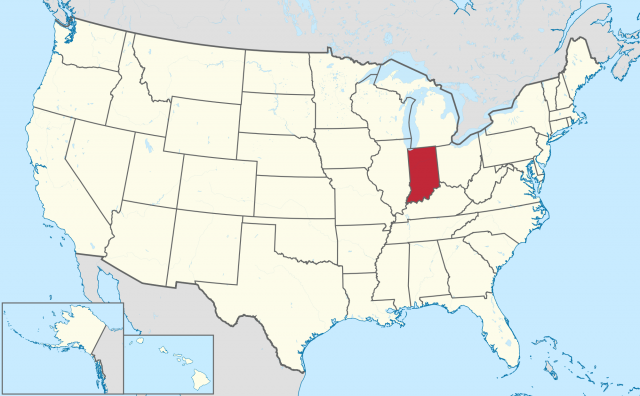The State of Indiana
AT A GLANCE
Name: Indiana means “land of Indians.”
Nickname: Hoosier State
Capital: Indianapolis
Size: 36,420 sq. mi. (94,328 sq km)
Population: 6,619,680 (2015 est)
Statehood: Indiana became the 19th state on December 11, 1816.
Electoral votes: 11 (2016)
U.S. Representatives: 10 (until 2016)
State tree: tulip poplar
State flower: peony
State bird: cardinal
Highest point: Wayne County, 1,257 ft. (383 m)

THE PLACE
Indiana, the smallest of the agricultural Midwest states, is made up of three main regions. The Great Lakes Plains are found in northern Indiana, along the state's border with Lake Michigan. This region has large sand dunes, which give way to more fertile land to the south. The center of the state is covered by the Till Plains, a region of fertile soil perfect for farming. The southernmost part of the state is covered by rolling hills and contains deposits of coal and petroleum. Indiana is also abundant in clay and limestone, and the state's rich soil is its most valuable resource.
Indiana's climate varies by region. In general, Indiana's weather is humid, with warm summers and mild winters. The weather in the Great Lakes Plains is the least extreme of all the regions, because winds from Lake Michigan warm the area in the winter and cool it in summer.
Facts and Firsts
- Abraham Lincoln spent much of his youth in Spencer County. His family moved there when he was seven years old.
- The first professional baseball game was played in Fort Wayne on May 4, 1871.
- The first long-distance auto race was held in Indianapolis in 1911. This race eventually became the famed Indianapolis 500.
- The Empire State Building, the Pentagon, the U.S. Treasury, and the capitols of 14 states have been built using limestone from huge deposits mined in southern Indiana.
- Indiana has more miles of interstate highway per square mile than any other state.
- Every Christmas, the town of Santa Claus receives more than a half-million letters for remailing.
THE PAST
The first known inhabitants of Indiana were prehistoric Native American tribes who built earthen mounds throughout the area.
In 1679, French explorer Rene-Robert Cavelier, Sieur de La Salle, explored the region while searching for a water route from Canada to the Pacific Ocean. Shortly after, French fur trappers and settlers began to move south from Canada and crossed Lake Michigan into Indiana. In 1763, the French lost control of the region to the British, who claimed all the land west of the original 13 colonies. During the Revolutionary War the Americans took control of the area, and in 1787 Indiana became part of the region known as the Northwest Territory.
In 1816, after a series of wars with Native Americans living in the area, Indiana officially became a state. The state's economy, which was dismal in its early years, improved during the 1850s with the construction of railroads. Manufacturing developments paved the way for large industrial growth. The Studebaker company of South Bend became the largest wagon manufacturer in the country, and Richard Gatling invented the first practical machine gun in Indianapolis in 1862.
Around the beginning of the 20th century, Standard Oil built a large oil refinery near Lake Michigan, and the United States Steel Corporation (now USX) constructed a large plant in the same area. Indiana's industries continued to grow throughout the century, despite a downturn during the Great Depression of the 1930s and another during the 1980s. Indiana's agriculture and manufacturing industries revived again at the beginning of the 1990s.
THE PRESENT
Indiana ranks among the top 20 states in manufacturing and agriculture. Although it is geographically the smallest of the Midwest states, it has a large population that is fueled by its many industries. Indiana's chief agricultural product is corn; the center of the state is part of the Midwestern Corn Belt. Indiana farmers also grow large amounts of soybeans and raise hogs.
Manufacturing, however, contributes the most to Indiana's economy, with oil refineries and steel mills yielding most of the state's gross product. While Indiana companies also produce a number of chemicals and pharmaceuticals, the traditional manufacture of automobiles and automobile parts remains the major industrial activity.
Born in Indiana
- Larry Bird, basketball player
- Bill Blass, fashion designer
- Jim Davis, cartoonist
- James Dean, actor
- Theodore Dreiser, author
- Michael Jackson, singer
- David Letterman, television show host
- Jane Pauley, broadcast journalist
- Cole Porter, songwriter
- J. Danforth “Dan” Quayle, U.S. vice president
- James Whitcomb Riley, poet
- Ned Rorem, composer
- Harland Sanders, founder of Kentucky Fried Chicken restaurants
- Twyla Tharp, dancer and choreographer
- Harold C. Urey, physicist
- Kurt Vonnegut, author
- Wilbur Wright, aviator